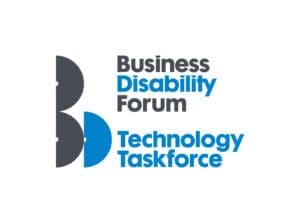Last updated: 4 August 2025
IT accessibility funding
This resource was created by our Technology Taskforce, a group of senior IT accessibility individuals from leading UK and global organisations. For more information, including how to join, see our website.

Introduction
Creating accessible IT systems is a must for every organisation – but it comes with expenses. In some organisations, if funding for accessibility-related processes is not properly considered, it can disrupt the whole project. It can even lead to accessibility being dropped as a core requirement. As with any other area of IT, funding needs to be thought out and managed.
This resource has been produced to help organisations consider the different types of activity that need to be funded, and to identify and manage their budgets.
Note: This guide only deals with IT accessibility. It does not address adjustments (or accommodations) to premises or business processes, to make the physical environment accessible.
For advice on physical accessibility, see our ‘Premises accessibility checklist’ and our guide for global organisations, ‘Access for all – Creating inclusive global built environments.’
We have created a resource, ‘Creating an IT accessibility policy,’ which provides more guidance on IT accessibility policies.
Accessibility areas and funding
There are different aspects of accessibility that might or will incur cost. Some are obvious, others less so. They are:
- Adjustments (or accommodations) for staff – Assistive Technology (AT), which includes specialist hardware, software, telephony (for example, specialist mobile phones, induction-loop phones), and PC changes (for example, laptops / Wi-Fi for staff working from home).
- Adjustments (or accommodations) for offices – You might also need AT in specific locations rather than for specific staff. Examples include PCs and software in training or exam rooms, hearing loop systems in conference venues or public offices.
- Installation and setup of these tools – On the whole, these are self-evident, but unusual cases can arise. For example, installing CCTV systems (allowing a user with sight loss to magnify a document on their desk), or systems to connect hearing aids with telephony.
- Subsequent training of the users in how to use these products.
- Ongoing technical support – This includes ongoing maintenance, repair and eventual replacement of such equipment and their accessories. For example, light bulbs for CCTV systems, toner cartridges for dedicated printers. These issues may sound trivial, but can become major problems, particularly for staff with sight loss or those with limited arm mobility.
- Initial product selection and testing – Before allowing products to be used within an organisation’s IT estate, organisations may want to select and test a range of a AT and/or consumer technology that can be deployed quickly for users who need it. This can include finding replacements for products that have reached end of life. Keeping an up-to-date catalogue of products available and approved for use in the organisation is good practice, as having to find products in response to an assessed need can greatly delay delivery to the user. Our resource, ‘Assistive Technology catalogues’ has more information.
- Developing and providing expertise in accessibility standards and system design best practice. This includes trained personnel to help advise IT projects and procurements in flight – such as where accessibility issues are identified during system development.
- Developing and providing expertise in accessibility testing, including the trained personnel to help administer this testing.
- Addressing accessibility issues in legacy systems.
- Providing the resource to help with the wider aspects of an organisation’s IT accessibility policy. This includes: awareness training, staff and customer liaison (feedback, disability networks, mentoring groups), strategy management (business objectives planning, reporting to the IT Accessibility Champion), and any other areas as needed.
Budget management in IT projects
What is in an IT project?
When we talk about IT projects we mean:
- Creating and maintaining standards and expertise
- Applying them in the various stages of projects and procurements
- Accessibility testing
- Fixing any faults identified
- Remedial work.
Who should be responsible for IT accessibility budgets?
There are two possible approaches to funding accessibility in IT projects. They are:
- A centralised budget provided to cover all accessibility-related expenditures.
- Expecting such costs to be factored into projects from the outset, as just another cost (and discipline) that needs to be addressed.
Projects and system owners might favour the first.
The advantage of the second is that it puts the onus on the project to ‘get it right’ from the start and hence save money overall. The disadvantage is that, when money is tight, projects and owners may be tempted to accept systems with accessibility flaws.
Ultimately, this is a question of IT accessibility strategy. The solution must suit the organisation’s circumstances.
Funding accessibility in existing IT systems
The above applies to both new systems and amendments to existing systems.
If undertaking a major rewrite, it makes sense to treat the project as if it were a new system development.
On the other hand, a change to a just small part of an older, inaccessible system may not be worth investing in – if the result is that that system remains inaccessible overall. This is always a question of judgement.
Finding money to address legacy system issues can be problematic for all disciplines, not just disability. There are two broad generic approaches:
- Setting up a dedicated fund for accessibility-related changes to existing systems, which can be used at any point in the system’s lifecycle. This approach allows issues with key systems to be addressed proactively.
- Addressing such faults only when these systems are renewed. This approach allows resources to be focused on new builds and stops the accessibility problem getting worse for an organisation.
Whether the first or the second strategy is the better approach for your organisation will depend on its unique circumstances. This is a question of judgement, strategy, and available budget.
Either way, we recommend:
- Conducting an initial survey of key systems to assess the scale of the problem.
- Ensuring that the owners of each system are on board and that they take responsibility for issues found with their systems. This may require that a record of such issues is kept, so that they can be factored into future work and a long-term plan can be put in place. It also allows temporary measures to be put in place for users affected – for example, workarounds, AT provision, adjustments or accommodations, and use of managers or other staff to support disabled staff or customers.
Funding adjustments and accommodations
Many disabled employees need adjustments or accommodations to let them work at their best. These can fall within the scope of IT teams’ work – such as AT, consumer technology, and other hardware and software.
Who should be responsible for budgets for adjustments and accommodations?
As with projects, there are two broad approaches:
- Expecting these costs to be covered by individual teams or departments’ budgets – usually the team or department in which the disabled employee in question works.
- Centralised budgets for specialist hardware and software, training and ongoing support.
Many organisations distribute budgets to specific teams or departments to help assess questions such as profitability, or the true costs per unit of a particular item. If so, this may not be a decision open to an IT Accessibility Champion.
The benefits of having a centralised budget
However, there is a distinct advantage for the second approach. Experience shows that funding decisions can greatly slow down the adjustment process. Recommendations may be clear and received early on, but take months to implement while managers try to agree ‘who pays?’
Having a centralised budget has two other advantages:
- It allows the overall spend on IT accessibility to be monitored as a strategic organisational cost. This means the Champion can report to the board on what the organisation is spending as a total, as a percentage of its overall IT budget, spend against target, sudden increases and decreases in spend etc.
- It can streamline the organisation’s adjustment process. Disabled employees may know what they need – because of a specialist’s assessment, or because of years of experience. Alternatively, many disabled employees need specialist help to identify what they need. A centralised budget allows these two options to integrate seamlessly into the process. There will be no temptation for a manager under budgetary pressure to resist the provision of necessary equipment, or the inclusion of someone with accessibility needs in their team. That addresses the ‘should we pay?’ question in all but the most extreme cases at a policy level.
Who owns the technology provided as an adjustment?
It is also important to be clear about who ultimately owns the technology that is provided as an adjustment or accommodation.
If a member of staff moves within a business, or leaves the business, can they take their equipment with them? Can they do this only where such equipment cannot be recycled? Can they do this if funding has been obtained from Access to Work?
In addition, can employees use this technology outside of work? Most organisations might not allow this (for example, because of security concerns), but some may consider exceptions.
An example might be allowing users of JAWS (Job Access With Speech, a commonly used screen reader) to take their dongles home, since the licence is on the dongle. Firstly, it costs nothing to let them use the software at home, giving them access to their home computer. Secondly, it allows them to practice using JAWS at home, which means they will be more confident (and productive) at work.
Conclusion
Arranging accessibility funding requires decisions on how proactive the organisation intends to be.
- Will there be a policy of fixing system issues immediately, or will the fixes occur only during updates or improvements to the system concerned?
- Will the organisation have a pre-arranged catalogue of ‘approved’ products which can be supplied at short notice? Or, will it institute a policy of looking at the equipment on the market at the time a need arises?
- A mixed regime of proactive and reactive elements is also a possibility, if the areas in which each element applies has been decided and recorded in advance.
Whichever option is chosen, the decision-making authority must be made clear in internal guidance. For example, elaborate whether an employee’s line manager can authorise reasonable adjustments, or whether it is up to an HR team.
The final decision must be made at a strategic level. Considering the advantages listed above, is funding to be paid from an organisational cost-centre, or at a project level?
If you require this content in a different format, contact enquiries@businessdisabilityforum.org.uk.
© This resource and the information contained therein are subject to copyright and remain the property of the Business Disability Forum. They are for reference only and must not be copied or distributed without prior permission.
